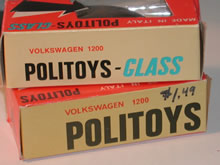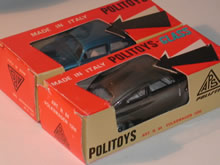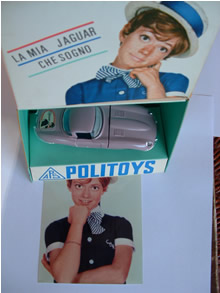|
|
||||||||||||||||||||||||||||||||
|
POLITOYS FIBRE-GLASS |
||||||||||||||||||||||||||||||||
|
1:41 scale
|
||||||||||||||||||||||||||||||||
|
In the early 60's the panorama of the Italian car models was dominated by Mercury, already existing in the 50's, and by Politoys. The former produced models in die casting, generally without opening parts, with unexceptional finishes. The latter produced models in colorful plastic that often seemed only the caricature of the true cars. The competition between the two companies and, above all, the attempt to compete with the most famous foreign producers, English and French, but also German, forced the companies to improve the quality of their production lines. Therefore Mercury resumed the models which they already produced and equipped them with glasses, interior, suspensions, jewel front-lights etc., introducing also some openings, improving the quality of the die casting and taking the models from the 1:48 scale to the 1:43 standard scale. Politoys too improved the working techniques of plastic materials, being able to produce models of gradually more acceptable quality, still in the original 1:41 scale. But its models, compared to those of the other companies, seemed, above all, nice toys, so they did not have great success among adult collectors. It was necessary, therefore, to make a decisive jump in quality; then, in 1964-65, it was proceeded on two parallel ways: the production of the die cast models in zamac, 1:43 scale (series "M", named also "500" series) and the production of another new series, that was placed side by side to the original plast series: this last series was called "Fibre-glass", because it was made in glass fiber. This new material allowed Politoys to produce models of good quality, decidedly comparable to the zamac models produced by the other companies. The body thickness was much thinner, the openings were more realistic; but the models were very much lighter and then Politoys thought well to increase the weight of theirs equipping them with an heavy zamac bottom, that also allowed a good rigidity to the model cars. But the glass fiber was of a whitish color and therefore, in order to sell the models, it was necessary to paint them by identical procedures to those adopted for the zamac models. The new models, finally, were beautiful reproductions, so beautiful that for them Politoys realized also a new series of boxes, with a celluloid window on two sides: all had to see the new models, in order to choose them instead of a Solido or a Corgi. But this effort of Politoys was not greatly appreciated by buyers because those models were too delicate to play with. It was enough to open the doors two or three times in order to damage the delicate paint job revealing, inexorably, the white of the glass fiber and rendering the new toy unattractive. Only collectors appreciated those models, but at that time there were too few of them to support the entire production. Politoys understood the error, abandoned the plastic series and the 1:41 scale and decided to follow the buyer's demand concentrating its production on the "M" series, in zamac, in which the most part of the Fibre-glass models was also produced. Worldwide collectors today enjoy collecting the Fibre-glass car models. It is enough to find few items (only eight, but would have had to be more than double the quantity) and it is possible to search the variety of colors without spending a fortune. Every fibre-glass model, in fact, can be found for less than 100 euros, with the exception of the special "Rita Pavone" Jaguar "E" type, which can fetch 500 euros or more. The produced models, in chronological order, are the following:
The last one is only a new special version of
the #89 item, but in the classic pink color of the famous Jaguar "E"
type that the singer Rita Pavone bought when she was at the height of
her success. With regard to the boxes, it is noted that they can
be of two types: with or without the word GLASS, but identical for colors
and general shape (please, see the photos below). Other models of the plastic series have also been sold with these boxes: for example, the motorboat with trailer, normally sold with the classic box of the plastic series was certainly sold also with the fibre-glass series box (without the GLASS word), but it holds its number of series 42. Finally, it has been noted than the models of
the fibre-glass series have been sold initially with the old box of
the plastic series. It has happened, for example, for the Volkswagen
1200 and the Ferrari 250GT "berlinetta". These models, which
we will define of pre-series, are the rarest and obviously have higher
values.
|
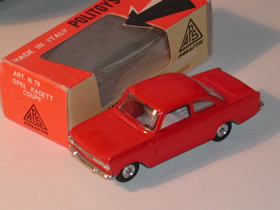 |
 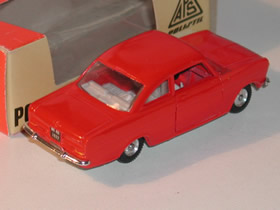 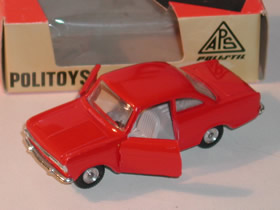 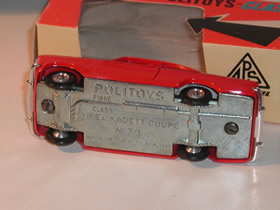 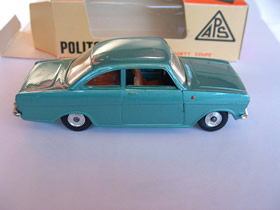
|
||||||||||||||||||||||||||||||
|
Art.79 (1965) - Opel Kadett
Coupé
Jewel front-lights, opening doors, folding seats, black steering wheel, suspensions, rear plate number MI-BO7032 or MI-BO90732 |
||||||||||||||||||||||||||||||||
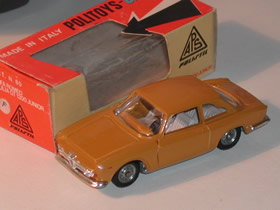 |
 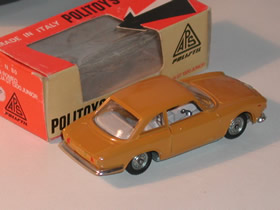 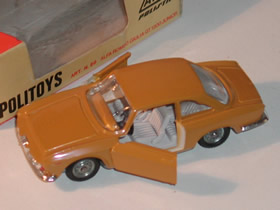 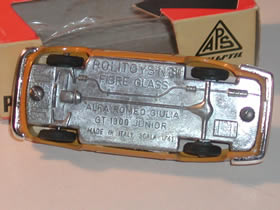 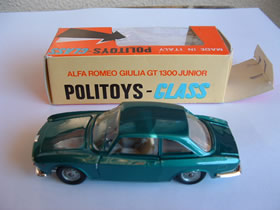 |
|||||||||||||||||||||||||||||||
|
Art.80 (1965) - Alfa Romeo
Giulia GT 1300 Jr.
Jewel front-lights, opening doors, folding seats, black steering wheel, chromed gear lever, suspensions, rear plate MI-BO in the cast body |
||||||||||||||||||||||||||||||||
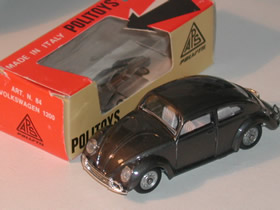 |
 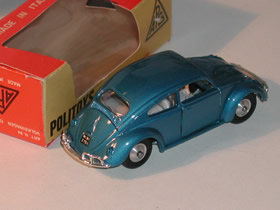 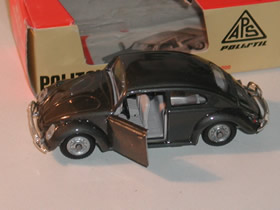 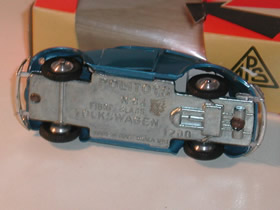 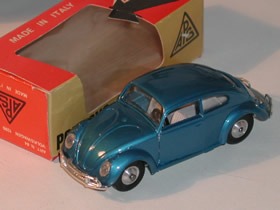 |
|||||||||||||||||||||||||||||||
|
Art.84 (1965) - Volkswagen
1200
Plastic front-lights, opening doors, folding seats, black steering wheel, suspensions, wheels of two various types, rear plate number MI-M72751 or MI-BO7032 |
||||||||||||||||||||||||||||||||
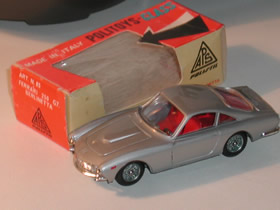 |
 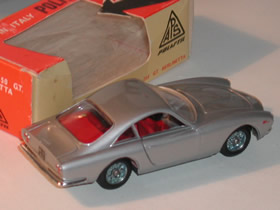 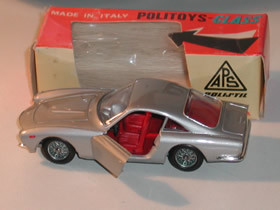  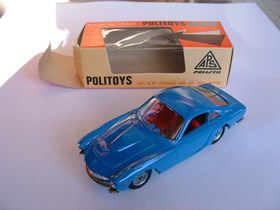 |
|||||||||||||||||||||||||||||||
|
Art.85 (1966) - Ferrari 250
GT Berlinetta
Jewel front-lights, opening doors, folding seats, black steering wheel, suspensions, spoked wheels, rear plate number MI-BO7032 |
||||||||||||||||||||||||||||||||
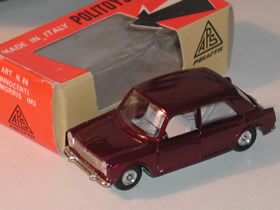 |
 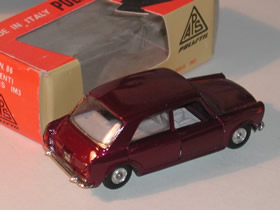 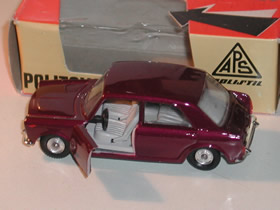 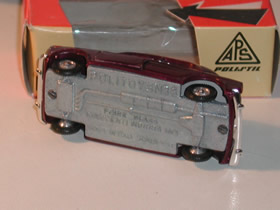 |
|||||||||||||||||||||||||||||||
|
Art.86 (1966) - Innocenti
Morris IM3
Plastic front-lights, opening doors, folding seats, black steering wheel, suspensions, rear plate number MI-BO7032 |
||||||||||||||||||||||||||||||||
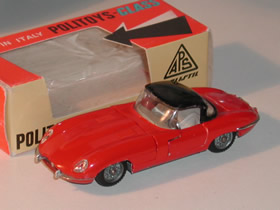 |
 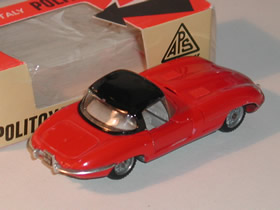 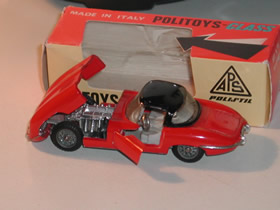 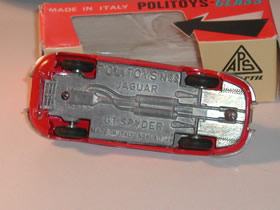 |
|||||||||||||||||||||||||||||||
|
Art.89 (1966) - Jaguar E
Type Hardtop
Plastic front-lights, opening doors, chromed steering wheel, opening front body, detailed engine, spoked wheels, not detachable black hardtop, suspensions, rear plate number MI-BO90732 (On the cast bottom: "JAGUAR G.T. SPYDER") |
||||||||||||||||||||||||||||||||
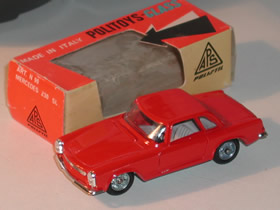 |
 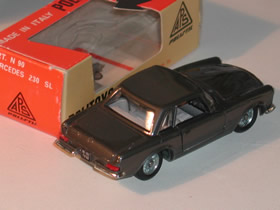 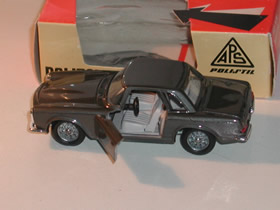 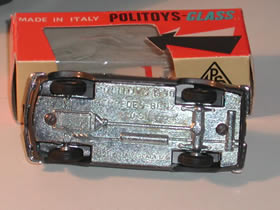 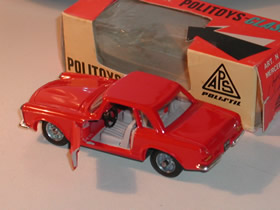 |
|||||||||||||||||||||||||||||||
|
Art.90 (1966) - Mercedes
Benz 230SL Hardtop
Plastic front-lights, opening doors, folding seats, black steering wheel, suspensions, spoked wheels, rear plate number MI-BO7032 |
||||||||||||||||||||||||||||||||
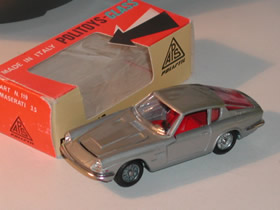 |
 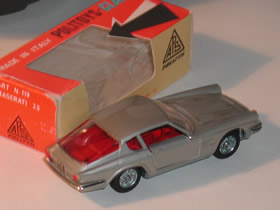 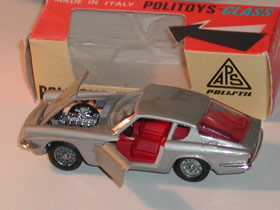 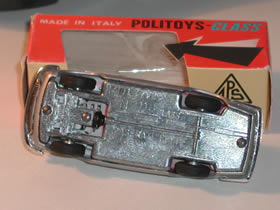 |
|||||||||||||||||||||||||||||||
|
Art.119 (1967) - Maserati
3.5 Mistral
Jewel front-lights, opening doors, folding seats, black steering wheel, opening hood, detailed engine, suspensions, spoked wheels, rear plate number MI-BO7032 (On the cast bottom: "MASERATI COUPE") |
||||||||||||||||||||||||||||||||
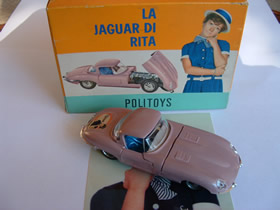 |
 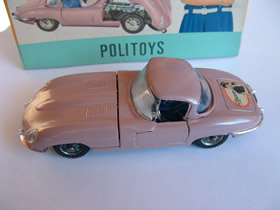 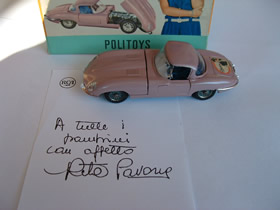 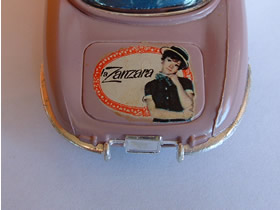  |
|||||||||||||||||||||||||||||||
|
Art.120 (1967) - Jaguar E
Type Hardtop
"Rita Pavone" version, pink, decal on the rear hood, special version box. Plastic front-lights, opening doors, chromed steering wheel, opening front body, detailed engine, spoked wheels, not detachable pink hardtop, suspensions. |
||||||||||||||||||||||||||||||||
|
N.2 curiosity: it seems that Teddy Reno, the husband of the singer, made secret agreements with Koelliker in order to reduce the power of the motor of Rita's beautiful Jaguar, but this could be only a rumour. |
|
|||||||||||||||||||||||||||||||
